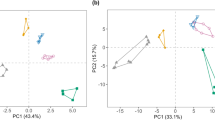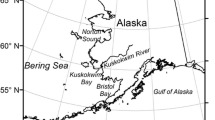Abstract
Energy allocation strategies of fishes during vitellogenesis fall along a spectrum from rapid transfer of ingested nutrients into yolk (income breeding) to drawing upon reserves stored in somatic tissues (capital breeding). Southern flounder, Paralichthys lethostigma, migrate from estuaries to offshore habitats to spawn, likely resulting in variability in nutrient intake. The effect of variable nutrient intake on egg composition depends upon the position of southern flounder on the income—capital breeding continuum. The essential fatty acid docosahexaenoic acid [DHA, 22:6(n-3)] was used as a biomarker to determine energy allocation strategy by measuring whether a shift in maternal diet at the start of the spawning season results in changes in the proportion of DHA in eggs. Treatment groups of flounder were fed a common diet and then switched to a high DHA diet, low DHA diet, or no change (control) diet after the first spawn, and spawned weekly for 8 weeks. DHA content of eggs changed within a few weeks of the diet change to reflect the dietary DHA content, consistent with an income breeding strategy. However, after about five weeks, females receiving the low DHA diet mobilized DHA stored in liver and white muscle tissues to reverse a decreasing trend in DHA content of eggs, evidence of a capital breeding strategy. These results suggest that southern flounder are income breeders under nutritionally favorable conditions but have the flexibility to use somatic stores to build yolk when nutrient availability is limited.



Similar content being viewed by others
References
Aksnes A, Gjerde B, Roald SO (1986) Biological, chemical and organoleptic changes during maturation of farmed Atlantic salmon. S salar Aquaculture 53:7–20
Almansa E, Martín MV, Cejas JR, Badía P, Jerez S, Lorenzo A (2001) Lipid and fatty acid composition of female gilthead seabream during their reproductive cycle: effects of a diet lacking n-3 HUFA. J Fish Biol 59:267–286
Basilone G, Guisande C, Patti B, Mazzola S, Cuttitta A, Bonanno A, Vergara AR, Maneiro I (2006) Effect of habitat conditions on reproduction of the European anchovy (Engraulis encrasicolus) in the Strait of Sicily. Fish Oceanogr 15(4):271–280
Burns CM, Fuiman LA (2019) Maternally derived nutrients influence fatty acid composition and predator evasion behavior of larval southern flounder, Paralichthys lethostigma. J Exp Mar Biol Ecol 514–515:41–47
Corey MM, Leaf RT, Brown-Peterson NJ, Peterson MS, Clardy SD, Dippold DA (2017) Growth and spawning dynamics of Southern Flounder in the north-central Gulf of Mexico. Mar Coast Fish 9(1):231–243
Craig JK, Smith WE, Scharf FS, Monaghan JP (2015) Estuarine residency and migration of Southern Flounder inferred from conventional tag returns at multiple spatial scales. Mar Coast Fish 7:450–463
Ditty JG, Zieske GG, Shaw RF (1988) Seasonality and depth distribution of larval fishes in the northern Gulf of Mexico above latitude 26°00′N. Natl Mar Fish Serv Fish Bull 86:811–823
Drent RH (2006) The timing of birds’ breeding seasons: the Perrins hypothesis revisited especially for migrants. Ardea 94:205–322
Enge KM, Mulholland R (1985) Habitat suitability index models: Southern and Gulf flounders. U.S. Fish and Wildlife Service Biological Report 82(10.92)
Faulk CK, Holt GJ (2005) Advances in rearing cobia Rachycentron canadum larvae in recirculating aquaculture systems: live prey enrichment and greenwater culture. Aquaculture 249:231–243
Flowers AM, Allen SD, Markwith AL, Lee LM (eds) (2019) Stock assessment of southern flounder (Paralichthys lethostigma) in the South Atlantic, 1989–2017. Joint report of the North Carolina Division of Marine Fisheries, South Carolina Department of Natural Resources, Georgia Coastal Resources Division, Florida Fish and Wildlife Research Institute, University of North Carolina at Wilmington, and Louisiana State University. NCDMF SAP-SAR-2019-01. 213 p
Fox CH, El-Sabaawi R, Paquet PC, Reimchen TE (2014) Pacific herring Clupea pallasii and wrack macrophytes subsidize semi-terrestrial detritivores. Mar Ecol Prog Ser 495:49–64
Fox CH, Paquet PC, Reimchen TE (2015) Novel species interactions: American black bears respond to Pacific herring spawn. BMC Ecol 15. https://doi.org/10.1186/s12898-015-0045-9
Fuiman LA (2018) Egg boon fatty acids reveal effects of a climatic event on a marine food web. Ecol Monogr 0:1–15
Fuiman LA, Faulk CK (2013) Batch spawning facilitates transfer of an essential nutrient from diet to eggs in a marine fish. Biol Lett 9:20130593
Fuiman LA, Ojanguren AF (2011) Fatty acid content of eggs determines antipredator performance of fish larvae. J Exp Mar Biol Ecol 407:155–165
Fuiman LA, Connelly TL, Lowerre-Barbieri SK, McClelland JW (2015) Egg boons: central components of marine fatty acid food webs. Ecology 96(2):362–372
Furuita H, Tanaka H, Yamamoto T, Shiraishi M, Takeuchi T (2000) Effects of n−3 HUFA levels in broodstock diet on the reproductive performance and egg and larval quality of the Japanese flounder, Paralichthys olivaceus. Aquaculture 187 (3–4):387–398
Furuita H, Tanaka H, Yamamoto T, Suzuki N, Takeuchi T (2002) Effects of high levels of n−3 HUFA in broodstock diet on egg quality and egg fatty acid composition of Japanese flounder, Paralichthys olivaceus. Aquaculture 210 (1–4):323–333
Gauthier G, Bêty J, Hobson KA (2003) Are greater snow geese capital breeders? New evidence from a stable-isotope model. Ecology 84(12):3250–3264
Hernandez FJ, Powers SP, Graham WM (2010) Detailed examination of ichthyoplankton seasonality from a high-resolution time series in the northern Gulf of Mexico during 2004–2006. Trans Am Fish Soc 139:1511–1525
Hirschfield MF (1980) An experimental analysis of reproductive effort and cost in the Japanese medaka Oryzias latipes. Ecology 61:282–292
Jönsson KI (1997) Capital and income breeding as alternative tactics of resource use in reproduction. Oikos 78(1):57–66
Kawaguchi K, Yamashita Y, Hayashi A (1990) Some aspects of spawning of the reared Japanese anchovy (Engraulis japonicas H.) in relation to the photoperiod, water temperature and starvation. Bull Jap Soc Fish Oceanogr 64:364–372
Litzow MA, Bailey KM, Prahl FG, Heintz R (2006) Climate regime shifts and reorganization of fish communities: the essential fatty acid limitation hypothesis. Mar Ecol Prog Ser 315:1–11
McBride RS, Somarakis S, Fitzhugh GR, Albert A, Yaragina NA, Wuenschel MJ, Alonso-Fernández A, Basilone G (2015) Energy acquisition and allocation to egg production in relation to fish reproductive strategies. Fish Fish 16:23–57
Parrish CC (2013) Lipids in Marine Ecosystems. ISRN Oceanography 2013:1–16
Perez KO, Fuiman LA (2015) Maternal diet and larval diet influence survival skills of larval red drum. J Fish Biol 86(4):1286–1304
Reagan RE Jr, Wingo WM (1985) Species profiles: life histories and environmental requirements of coastal fishes and invertebrates (Gulf of Mexico): Southern Flounder. U.S. Fish and Wildlife Service Biological Report 82(11.30)
Røjbek M, Jacobsen C, Tomkiewicz J, Støttrup J (2012) Linking lipid dynamics with the reproductive cycle in Baltic cod Gadus morhua. Mar Ecol Prog Ser 47:215–234
Sargent JR, Bell JG, Bell MV, Henderson RJ, Tocher DR (1995) Requirement criteria for essential fatty acids. Symposium of European Inland Fisheries Advisory Commission. J Appl Icthyol 11:183–198
Sargent JR, McEvoy LA, Bell LG (1997) Requirements, presentation and sources of polyunsaturated fatty acids in marine fish larval feeds. Aquaculture 155(1–4):117–127
Sargent JR, Bell G, McEvoy L, Tocher D, Estevez A (1999) Recent developments in the essential fatty acid nutrition of fish. Aquaculture 1777:191–199
Somarakis S, Palomera I, Garcia A, Quintanilla L, Koutsikopoulos C, Uriarte A, Motos L (2004) Daily egg production of anchovy in European waters. ICES J Mar Sci 61(6):944–958
Tocher DR, Harvie DG (1988) Fatty acid composition of the major phosphoglycerides from fish neural tissues; (n-3) and (n-6) polyunsaturated fatty acids in rainbow trout (Salmo gairdneri) and cod (G. morhua) brains and retinas. Fish Physiol Biochem 5:229–239
Tocher D, Sargent JR (1984) Analyses of lipids and fatty acids in ripe roes of some northwest European marine fish. Lipids 19:492–499
Watanabe WO, Carroll PM, Daniels HV (2001) Sustained, natural spawning of southern flounder Paralichthys lethostigma under an extended photothermal regime. J World Aquacult Soc 32:153–166
Wheatley KE, Bradshaw CJA, Harcourt RG, Hindell MA (2008) Feast or famine: evidence for mixed capital-income breeding strategies in Weddell seals. Oecologia 155:11–20
Winne CT, Willson JD, Whitefield Gibbons J (2006) Income breeding allows an aquatic snake Seminatrix pygaea to reproduce normally following prolonged drought-induced aestivation. J Anim Ecol 75:1352–1360
Acknowledgements
All animal procedures were reviewed and approved by the Institutional Animal Care and Use Committee at the University of Texas at Austin. The authors thank Jeff Kaiser and Rene Lopez for helping with egg collection and broodstock maintenance, Cynthia Faulk for assisting with gas chromatography and fatty acid analyses, and Dr. Kenneth Webb for assistance with project development. CB would also like to thank her master’s thesis committee members Dr. Brad Erisman and Dr. Andrew Esbaugh. This study was supported by the Perry R. Bass Chair in Fisheries and Mariculture, an endowment at the University of Texas Marine Science Institute. This is contribution number 1721 of the University of Texas Marine Science Institute.
Author information
Authors and Affiliations
Corresponding author
Additional information
Publisher's Note
Springer Nature remains neutral with regard to jurisdictional claims in published maps and institutional affiliations.
Rights and permissions
About this article
Cite this article
Burns, C.M., Fuiman, L.A. Determining the position of southern flounder Paralichthys lethostigma on the reproductive energy allocation spectrum using an essential fatty acid as a maternal dietary biomarker. Environ Biol Fish 103, 1137–1148 (2020). https://doi.org/10.1007/s10641-020-01013-3
Received:
Accepted:
Published:
Issue Date:
DOI: https://doi.org/10.1007/s10641-020-01013-3




